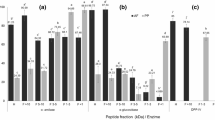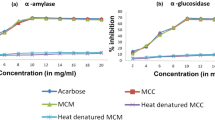Abstract
Characterized by uncontrolled, long-term high blood sugar levels, diabetes mellitus affects ever increasing numbers of people worldwide. Type 2 diabetes is the most common, accounting for 95% of reported cases. The main objective of this article was to evaluate the in vitro antidiabetic effects of hydrolysates from Lima bean (Phaseolus lunatus L.) proteins. The hydrolysates were produced with either the Alcalase®-Flavourzyme® (AF) or pepsin-pancreatin (PP) sequential systems and peptide fractions (F > 10, F5-10, F3-5, 1–3 and < 1 kDa) isolated from them. Assays of in vitro inhibitory activity against the enzymes α-amylase, α-glucosidase, and dipeptidyl peptidase IV (DPP-IV) were done for all the hydrolysates and peptide fractions. Degree of hydrolysis (DH) was highest in the AF hydrolysates. Protein hydrolysates (PH) or ultrafiltered peptide fractions (UFPF) test concentrations (mg protein mL−1) were in α-amylase, PP (100 mg mL−1) and AF (50 mg mL−1); α-glycosidase, PP (200 mg mL−1) and AF (10 mg mL−1); and DPP-IV, PP and AF (10 mg mL−1). Among the AF products, inhibitory activities were highest in the F > 10 kDa fraction against α-amylase (IC50 = 54.61 ± 1.76 mg protein mL−1), the F5-10 kDa (IC50 = 124.14 ± 3.05) against α-glucosidase and the F5-10 kDa (IC50 = 1.93 ± 0.20) against DPP-IV. For the PP products, inhibitory activities were highest in the F < 1 kDa (IC50 = 55.79 ± 1.06). None of the highly inhibitory hydrolysates or peptide fractions exhibited cytotoxicity in vitro versus Vero cells. These fractions are potential ingredients for inclusion in functional foods aimed at controlling type 2 diabetes.


Similar content being viewed by others
Data Availability
All data and material are available.
References
Ahrén B et al (2011) Mechanisms of action of the dipeptidyl peptidase-4 inhibitor vildagliptin in humans. Diabetes Obe Meta 13:775–783. https://doi.org/10.1111/j.1463-1326.2011.01414.x
Ali NM et al (2016) Comparison of free amino acids, antioxidants, soluble phenolic acids, cytotoxicity and immunomodulation of fermented mung bean and soybean. J Sci Food Agric 96:1648–1658. https://doi.org/10.1002/jsfa.7267
Betancur-Ancona D et al (2014) Enzymatic hydrolysis of hard-to-cook bean (Phaseolus vulgaris L.) protein concentrates and its effects on biological and functional properties. Int j Food Sci Technol 49:2–8. https://doi.org/10.1111/ijfs.12267
Camargo Filho I et al (2008) Antiviral activity and mode of action of a peptide isolated from sorghum bicolor. Phytomed Urban Fischer 15:202–208. https://doi.org/10.1016/J.PHYMED.2007.07.059
Castañeda-Pérez E et al (2019) Enzymatic protein hydrolysates and ultrafiltered peptide fractions from Cowpea Vigna unguiculata L bean with in vitro antidiabetic potential. J Iran Chem Soc 16:1773–1781. https://doi.org/10.1007/s13738-019-01651-0
Chel-Guerrero L et al (2007) Physicochemical and structural characterization of Lima Bean (Phaseolus lunatus) globulins. LWT Food Sci Technol. 40:1537–1544. https://doi.org/10.1016/j.lwt.2006.11.014
de Souza Rocha T et al (2014) Impact of germination and enzymatic hydrolysis of cowpea bean (Vigna unguiculata) on the generation of peptides capable of inhibiting dipeptidyl peptidase IV. Food Res Int 64:799–809. https://doi.org/10.1016/j.foodres.2014.08.016
Duranti M, Gius C (1997) Legume seeds: protein content and nutritional value. Field Crop Res 53:31–45. https://doi.org/10.1016/S0378-4290(97)00021-X
Horwitz W, Latimer GW (2005) Official methods of analysis of AOAC International, 18th edn. AOAC International, Gaithersburg
Kalra S (2014) Alpha glucosidase inhibitors. J Pak Med Assoc 64:474–476
Kang M-G, Yi S-H, Lee J-S (2013) Production and characterization of a new α-glucosidase inhibitory peptide from Aspergillus oryzae N159–1. Mycobiology 41:149–154. https://doi.org/10.5941/MYCO.2013.41.3.149
Lacroix IME, Li-Chan ECY (2013) Inhibition of dipeptidyl peptidase (DPP)-IV and α-glucosidase activities by pepsin-treated whey proteins. J Agric Food Chem 61:7500–7506. https://doi.org/10.1021/jf401000s
Lee HJ et al (2011) Novel tripeptides with a-glucosidase inhibitory activity isolated from silk cocoon hydrolysate. J Agric Food Chem 59:11522–11525. https://doi.org/10.1021/jf202686m
Li-Chan ECY et al (2012) Peptides derived from Atlantic salmon skin gelatin as dipeptidyl-peptidase IV inhibitors. J Agric Food Chem 60:973–978. https://doi.org/10.1021/jf204720q
Liao TT et al (2010) Sensitivity of morphological change of Vero cells exposed to lipophilic compounds and its mechanism. J Hazard Mater 179:1055–1064. https://doi.org/10.1016/j.jhazmat.2010.03.113
Lorey S et al (2003) Different modes of dipeptidyl peptidase IV (CD26) inhibition by oligopeptides derived from the N-terminus of HIV-1 Tat indicate at least two inhibitor binding sites. Eur J Biochem 270:2147–2156. https://doi.org/10.1046/j.1432-1033.2003.03568.x
Lowry OH et al (1951) Protein measurement with the Folin phenol reagent. J Biol Chem 193:265–275. https://doi.org/10.1016/0304-3894(92)87011-4
Martínez-Castillo J et al (2007) Gene flow and genetic structure in the wild–weedy–domesticated complex of Phaseolus lunatus L. in its Mesoamerican center of domestication and diversity. Crop Sci 47:58–66. https://doi.org/10.2135/cropsci2006.04.0241
Mojica L, Chen K, de Mejía EG (2015) Impact of commercial precooking of common bean (Phaseolus vulgaris) on the generation of peptides, after pepsin-pancreatin hydrolysis, capable to inhibit dipeptidyl peptidase-IV. J Food Sci 80:H188–H198. https://doi.org/10.1111/1750-3841.12726
Mora-Escobedo R et al (2009) Effect of protein hydrolysates from germinated soybean on cancerous cells of the human cervix: an in vitro study. Plant Foods Hum Nutr 64:271–278. https://doi.org/10.1007/s11130-009-0131-2
Murphy L et al (2008) Proteomic investigation of taxol and taxotere resistance and invasiveness in a squamous lung carcinoma cell line. Biochim Biophys Acta Proteins Proteom 1784:1184–1191. https://doi.org/10.1016/j.bbapap.2008.04.014
Ngoh Y-Y, Gan C-Y (2016) Enzyme-assisted extraction and identification of antioxidative and α-amylase inhibitory peptides from Pinto beans (Phaseolus vulgaris cv. Pinto). Food Chem 190:331–337. https://doi.org/10.1016/J.FOODCHEM.2015.05.120
Ngoh Y-Y, Lim TS, Gan C-Y (2016) Screening and identification of five peptides from pinto bean with inhibitory activities against α-amylase using phage display technique. Enzyme Microb Technol 89:76–84. https://doi.org/10.1016/J.ENZMICTEC.2016.04.001
Nielsen PM, Petersen D, Dambmann C (2001) Improved method for determining food protein degree of hydrolysis. J Food Sci 66:642–646. https://doi.org/10.1111/j.1365-2621.2001.tb04614.x
Nongonierma AB, Fitzgerald RJ (2013) Dipeptidyl peptidase IV inhibitory and antioxidative properties of milk protein-derived dipeptides and hydrolysates. Peptides 39:157–163. https://doi.org/10.1016/j.peptides.2012.11.016
Nuñez-Aragón PN et al (2019) Protein hydrolysates and ultrafiltered < 1 KDa fractions from Phaseolus lunatus, Phaseolus vulgaris and Mucuna pruriens exhibit antihyperglycemic activity, intestinal glucose absorption and α -glucosidase inhibition with no acute toxicity in rodents. J Sci Food Agric 99:587–595. https://doi.org/10.1002/jsfa.9219
Obiro WC, Zhang T, Jiang B (2008) The nutraceutical role of the Phaseolus vulgaris α-amylase inhibitor. Br J Nutr 100:1–12. https://doi.org/10.1017/S0007114508879135
Oseguera-Toledo ME, Gonzalez de Mejia E, Amaya-Llano SL (2015) Hard-to-cook bean (Phaseolus vulgaris L.) proteins hydrolyzed by alcalase and bromelain produced bioactive peptide fractions that inhibit targets of type-2 diabetes and oxidative stress. Food Res Int 76:839–851. https://doi.org/10.1016/j.foodres.2015.07.046
Polanco-Lugo E et al (2014) Effects of sequential enzymatic hydrolysis on structural, bioactive and functional properties of Phaseolus lunatus protein isolate. Food Sci Technol 34:441–448. https://doi.org/10.1590/1678-457x.6349
Power O et al (2014) Food protein hydrolysates as a source of dipeptidyl peptidase IV inhibitory peptides for the management of type 2 diabetes. Proc Nutr Soc 73:34–46. https://doi.org/10.1017/S0029665113003601
Ruiz-Ruiz J et al (2013) Angiotensin I-converting enzyme inhibitory and antioxidant peptide fractions from hard-to-cook bean enzymatic hydrolysates. J Food Biochem 37:26–35. https://doi.org/10.1111/j.1745-4514.2011.00594.x
Ryder K et al (2016) Towards generation of bioactive peptides from meat industry waste proteins: generation of peptides using commercial microbial proteases. Food Chem. 208:42–50. https://doi.org/10.1016/j.foodchem.2016.03.121
Segura-Campos M et al (2013) Antioxidant activity of Vigna unguiculata L. walp and hard-to-cook Phaseolus vulgaris L. protein hydrolysates. CYTA J Food 11:208–215. https://doi.org/10.1080/19476337.2012.722687
Segura-Campos MR, Chel-Guerrero LA, Betancur-Ancona DA (2010) Angiotensin-I converting enzyme inhibitory and antioxidant activities of peptide fractions extracted by ultrafiltration of cowpea Vigna unguiculata hydrolysates. J Sci Food Agric 90:2512–2518. https://doi.org/10.1002/jsfa.4114
Velarde-Salcedo AJ et al (2013) In vitro inhibition of dipeptidyl peptidase IV by peptides derived from the hydrolysis of amaranth (Amaranthus hypochondriacus L.) proteins. Food Chem 136:758–764. https://doi.org/10.1016/j.foodchem.2012.08.032
Vernaza MG et al (2012) Antioxidant and antiinflammatory properties of germinated and hydrolysed Brazilian soybean flours. Food Chem 134:2217–2225. https://doi.org/10.1016/j.foodchem.2012.04.037
Vioque J et al (1999) Production and characterization of an extensive rapeseed protein hydrolysate. J Am Oil Chem Soc 76:819–823. https://doi.org/10.1007/s11746-999-0071-x
Yan J et al (2019) Bioactive peptides with antidiabetic properties: a review. Int J Food Sci Technol 54:1909–1919. https://doi.org/10.1111/ijfs.14090
Yust MM et al (2004) Determination of tryptophan by high-performance liquid chromatography of alkaline hydrolysates with spectrophotometric detection. Food Chem 85:317–320. https://doi.org/10.1016/j.foodchem.2003.07.026
Zhang Y et al (2016) Molecular mechanisms of novel peptides from silkworm pupae that inhibit α-glucosidase. Peptides 76:45–50. https://doi.org/10.1016/j.peptides.2015.12.004
Funding
The authors thank the Consejo Nacional de Ciencia y Tecnología (CONACYT-México) and Red Temática de Farmoquímicos for their Project support to this publication. CONACYT is acknowledged for providing the MSc scholarship for the K. Jiménez.
Author information
Authors and Affiliations
Contributions
EC-P: Conceptualization, Formal analysis and investigation; Writing—original draft preparation. KJ-M: Formal analysis and investigation. AC-R: Methodology: Writing—review and editing. LC-G: Conceptualization, Supervision. DB-A: Conceptualization, Formal analysis and investigation, Writing—review and editing, Supervision. Additional declarations for articles in life science journals that report the results of studies involving humans and/or animals.
Corresponding author
Ethics declarations
Conflict of interest
The authors declare no conflicts of interest exist in the submission of this manuscript.
Ethics Approval
This article does not contain any studies with human or animal subjects.
Consent for Publication
All authors have read and approved the manuscript.
Additional information
Publisher's Note
Springer Nature remains neutral with regard to jurisdictional claims in published maps and institutional affiliations.
Rights and permissions
About this article
Cite this article
Castañeda-Pérez, E., Jiménez-Morales, K., Castellanos-Ruelas, A. et al. Antidiabetic Potential of Protein Hydrolysates and Peptide Fractions from Lima Bean (Phaseolus lunatus L): An In Vitro Study. Int J Pept Res Ther 27, 1979–1988 (2021). https://doi.org/10.1007/s10989-021-10226-8
Accepted:
Published:
Issue Date:
DOI: https://doi.org/10.1007/s10989-021-10226-8




